what it means to ahve a very low c reactive protein score
Examination Quick Guide
The C-reactive protein (CRP) test measures the amount of CRP in your blood. CRP is a type of protein that is associated with inflammation in the torso. CRP is measured using a small claret sample drawn from a vein in your arm.
Your doctor might club a CRP exam if y'all have symptoms of inflammation. Doctors also utilize CRP levels to guide treatment of a bacterial infection or to monitor inflammatory processes that occur in some autoimmune diseases.
About the Exam
Purpose of the test
Doctors measure out CRP because it is a marker of inflammation, which is function of the body'due south fight against illness or injury. Your doctor might order a CRP test to:
- Bank check for infection if yous accept symptoms of inflammation such as fever, chills, redness or flushing, nausea, vomiting, rapid breathing, and/or rapid heart rate
- Guide treatment of sepsis, a life-threatening complication where the body'due south response to a bacterial infection triggers inflammation throughout the body
- Monitor flare-ups of a chronic inflammatory autoimmune disease such as lupus or rheumatoid arthritis
- Appraise the handling of a chronic inflammatory condition
What does the test measure?
A C-reactive protein exam measures the amount of CRP in your claret. CRP levels tin can reflect the presence and severity of inflammation in your body.
CRP is a protein produced past the liver. When bacteria or other cellular invaders threaten the body, the liver releases CRP into the bloodstream to assistance organize the body'south defenses. This early response is called an acute phase response. It is also referred to every bit inflammation or an inflammatory response. The acute phase response also can occur in chronic weather condition, including some autoimmune diseases.
As an early responder, CRP is technically known as a positive astute phase reactant. Its level, measured from a blood sample, gives your doctor information about the presence of inflammation and how serious it is. However, CRP levels do not tell the doctor where in your body the inflammation is located or what is causing it.
Loftier-sensitivity CRP (hs-CRP) testing is a different course of testing that identifies very depression concentrations of CRP. Although both tests measure CRP, hs-CRP is considered a separate test with singled-out uses.
When should I have a C-Reactive Protein test?
CRP testing is done primarily to find or monitor health weather condition that are associated with inflammation. For example, a CRP test may be recommended if you lot take signs and symptoms of:
- Bacterial or viral infection
- Autoimmune disease, including rheumatoid arthritis and lupus
- Minor inflammation associated with a range of problems such as smoking, diabetes, and physical trauma
There are not strict guidelines for when CRP testing is prescribed, so it is important to consult with your health care provider to determine if a CRP test is appropriate in your situation.
Finding a C-Reactive Protein test
How to go tested
C-reactive poly peptide testing is typically performed simply after being prescribed by a doc or other health professional.
After your doctor orders a CRP test, the blood sample can be drawn at a hospital or clinic laboratory or, if y'all are hospitalized, at your bedside. In some cases, the sample might be collected at your doctor'southward office. The measurement of CRP takes place in a laboratory.
Can I take the test at home?
Options are bachelor for at-abode CRP testing. For near of these tests, you collect a claret sample at home and and so postal service it to a laboratory where it tin can be analyzed.
The claret sample for at-home CRP tests is taken from your fingertip using a very small needle called a lancet. You then apply a drib of blood to a special exam paper that tin can be processed by the lab. Results are usually provided through a secure website or smartphone app.
Calm CRP tests tin can be purchased without a prescription, only it is generally best to consult with your medico before taking an at-home CRP test. Your doctor tin discuss the appropriateness of testing and help interpret any test results.
How much does the exam cost?
Many factors contribute to the price of a CRP test, including the materials needed to carry out the test, the fee for the phlebotomist who draws your blood, the laboratory'southward fee for analyzing the sample, and the fee from your doctor's office.
Your insurance coverage will decide your out-of-pocket cost. Insurance mostly covers CRP testing, but depending on your policy, you might owe a deductible or a copay. If you lot are in doubt, check with your insurance provider.
If you lot are uninsured, and so discuss the cost with your doctor or with the infirmary or laboratory administrator. Some wellness care institutions have fiscal advancement offices that tin can assist you with concerns nearly cost.
Club your at-home health test online
A convenient, affordable, and discreet way of getting accurate test results quickly.


-
Unimposing Packaging
Free next day shipping and confidential results in 2-5 days
-
Trustworthy Medical Support
Real-fourth dimension support services from our national network of physicians and nurses
-
Health Records You Control
Privacy at your fingertips, integrated with your pick of apps and wearables
Taking the C-Reactive Protein Test
C-reactive protein is measured from a blood sample that comes from a vein. A small corporeality of blood will be drawn from your arm. The blood draw normally takes place in a infirmary or clinic laboratory, but it can also exist done in a md's office or at the bedside in a infirmary. The claret draw takes only a few minutes.
Earlier the test
Your physician'due south part may review your medications before the test. Some medications, including nonsteroidal anti-inflammatory drugs and statins, can impact CRP levels. Magnesium supplements as well can affect your CRP level. For this reason, make sure to tell your doc most any medications or supplements that you take and ask whether you should adjust your medications before the exam.
During the test
A phlebotomist will take a blood sample from a vein in your arm. The phlebotomist will place a rubber tourniquet around your upper arm and ask you to pump your fist a few times so that the vein tin can be located. The technician will cleanse that area of your arm with an alcohol wipe and, when the peel is dry, insert a needle and draw out a vial of claret.
There may be a cursory pinching awareness when the needle is inserted. The phlebotomist volition and so remove the tourniquet, withdraw the needle, briefly apply pressure to the site, and place a bandage over it.
Afterwards the test
Providing a claret sample is a routine, low-adventure procedure. You lot might have slight pain or bruising at the injection site, simply these symptoms disappear chop-chop. You will be able to get on with your day and normal activities when y'all leave the laboratory.
Very rarely, there may be more than serious effects such every bit light-headedness or infection.
These complications are very unlikely, but if you notice any ongoing effects after your test, brand sure to contact your doctor.
C-Reactive Protein Test Results
Receiving test results
The results of your CRP test should be available inside a business day or two. Depending on your wellness care provider, yous may receive the results via electronic communication or directly from your doc's role.
Interpreting examination results
Your exam result is the level of CRP in your claret. Depending on the laboratory's standards, the outcome is expressed in milligrams per deciliter (mg/dL) or milligrams per liter (mg/L). The study might indicate that the level is loftier, low, or normal.
Although "normal" CRP levels vary from lab to lab, it is generally accepted that a value of 0.eight-1.0 mg/dL (or 8-ten mg/50) or lower is normal. Most healthy adults accept CRP levels lower than 0.iii mg/dL.
A minor summit in CRP level—generally 0.three to 1.0 mg/dL—does non necessarily mean you accept an illness that requires treatment. CRP levels may be higher in females, patients on hormone replacement therapy and loftier trunk mass index. Mildly elevated CRP tin exist associated with indisposition and depression. Your medico will consider these factors when interpreting your CRP examination upshot.
A CRP level college than 1.0 mg/dL unremarkably suggests that there is inflammation in your trunk, simply it does not identify the cause or the location of that inflammation. Very high levels of CRP can be associated with various types of infections, autoimmune diseases, some cancers, and weather affecting the lungs or pancreas. If your CRP level is in this range, your md may order boosted tests to get more than information earlier making a diagnosis.
Because of variations in laboratory methods and reference ranges, it is best to consult with your md for clarity about your results.
Related Tests
Comparing and contrasting a C-reactive protein test and a high-sensitivity C-reactive protein test
The loftier-sensitivity C-reactive protein (hs-CRP) test uses a unlike technique to measure out CRP. This allows the hs-CRP test to observe very low elevations of CRP.
Although the substance being measured, CRP, is the same, hs-CRP is a separate test that is used primarily to assess risk of heart affliction.
Comparing and contrasting a C-reactive protein test and an erythrocyte sedimentation charge per unit examination
The erythrocyte sedimentation rate (ESR) is some other way to mensurate inflammation with a sample of blood. It is a less directly measure than the CRP test. Because the CRP level responds much more than apace to changes in inflammatory action, it tin give doctors more timely information.
The ESR has a office in sure conditions where the information it provides may contribute to the decision-making process. Your physician volition decide whether both tests are needed to better empathise your status. Other names for the ESR include SED charge per unit, sedimentation rate, and Westergren sedimentation rate.
Sources
A.D.A.M. Medical Encyclopedia. C-reactive protein. Updated Jan 31, 2021. Accessed September 15, 2021. https://medlineplus.gov/ency/article/003356.htm
Albert MA, Glynn RJ, Buring J, Ridker PM. C-reactive protein levels amongst women of various ethnic groups living in the United States (from the Women's Health Study). Am J Cardiol. 2004;93(10):1238-1242. doi:10.1016/j.amjcard.2004.01.067
American Lath of Internal Medicine. ABIM laboratory reference ranges. Updated July 2021. Accessed September 15, 2021. https://www.abim.org/Media/bfijryql/laboratory-reference-ranges.pdf
American Lodge for Clinical Pathology. Choosing wisely. Updated February iii, 2015. Accessed September 15, 2021. https://www.choosingwisely.org/clinician-lists/american-society-clinical-pathology-erythrocyte-sedimentation-rate-for-acute-phase-inflammation/
ARUP Consult. Inflammatory markers. Updated October 2020. Accessed September 20, 2021. https://arupconsult.com/content/inflammatory-markers
Centers for Disease Command and Prevention. What is sepsis? Updated August 17, 2021. Accessed September 20, 2021. https://www.cdc.gov/sepsis/what-is-sepsis.html
Kushner I. Acute stage reactants. In: Furst DE, ed. UpToDate. Updated July 30, 2021. Accessed September fifteen, 2021. https://www.uptodate.com/contents/acute-phase-reactants
Lapić I, Padoan A, Bozzato D, Plebani Thou. Erythrocyte sedimentation rate and C-reactive poly peptide in acute inflammation: meta-assay of diagnostic accuracy studies. Am J Clin Pathol. 2020(1):14-29. doi: https://doi.org/ten.1093/ajcp/aqz142
MedLinePlus: National Library of Medicine. C-reactive protein (CRP) examination. Updated December 30, 2020. Accessed September 15, 2021. https://medlineplus.gov/lab-tests/c-reactive-protein-crp-examination/
Nehring SM, Goyal A, Bansal P, Patel BC. C reactive protein. In: StatPearls. Updated May 10, 2021. Accessed September 15, 2021. https://www.statpearls.com/ArticleLibrary/viewarticle/18744
Inquire a Laboratory Scientist

Source: https://www.testing.com/tests/c-reactive-protein-crp/
0 Response to "what it means to ahve a very low c reactive protein score"
Post a Comment